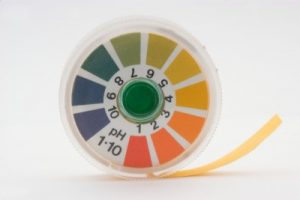
Just like your swimming pool or your fish aquarium, your body pH is something you must not ignore if you wish to maintain perfect health, regain lost immunity, or maintain proper weight.
Your body reacts the same as an aquarium that turns icky and toxic when the pH is out of balance. The farther your pH travels from center, the more health problems can develop, and it may be difficult to maintain your desired weight.
When Your pH Swings
An acidic pH has a low ability to attract hydrogen ions, while an alkaline pH has the ability to attract hydrogen ions. The “p” stands for potential and the “H” stands for hydrogen. In other words, pH is the potential of your body to attract hydrogen ions to secure balance and health.
Every different type of liquid solution in your body has its own balanced, individual pH.
The pH scale for freshwater ranges from 0-14, and in the past, most people “assumed” that a healthy body pH was that of fresh water – 7.0. Using my environmental background, I know that this can be too alkaline for your body, though.
According to my research and environmental experience, an average balanced body pH should be between 6.4 and 6.6 because we are salt water animals – even though we drink fresh water. This is important because salt is very alkaline, and you don’t want to become too alkaline.

Acidity can breed disease, and alkalinity can damage your kidneys if you don’t drink enough water. Readings below 6.4 pH are considered acidic, while readings above 6.6 pH are climbing in alkalinity.
It’s important to keep your pH balanced.
I believe that your average body pH is slightly lower than the pH of your blood because humans naturally have acids circulating within them that make your balanced pH a little lower than your blood.
The most important acids that occur naturally in your body are amino acids, fatty acids, ascorbic acid, lactic acid, uric acid, and hydrochloric acid.
Your blood maintains a more alkaline pH balance averaging between 7.1 and 7.4 because you do not want acidic blood.
What’s Your pH?
There are a variety of ways to determine your body’s pH. The most practical and inexpensive method is to find the pH level of your urine and saliva using litmus paper.
Your body pH will vary with what you eat, so I recommend measuring both the pH of your saliva and your urine twice a day – when you get up in the morning before you eat or drink anything, and the last thing before bed after you’ve eaten who knows what during the day.
Keep in mind that when determining your body’s pH, you want to look at the averages and eating trends over a monitored period of time. A 10-day average works really well and gives you a great understanding how your body responds to what you eat.

My pH Information
To make this process easy and understandable, I write about the pH testing process in my 10-Steps To Detoxification eBook, which is free to download off my website.
You’ll want to get:
- pH test strips and use one strip at a time;
- My 75/25 Eating Chart to help you select the right foods for your pH;
- A calendar to record both your urine and saliva pH readings over a ten-day period.
My 75/25 Eating Plan

My 75-25 Eating Plan will help you select the right pH balanced foods based on your individual pH, and this will help you in adjusting the correct proportions of alkaline vs. acidic food choices at every meal or snack.
Keep in mind, you can eat both acidic and alkaline foods at each meal, but it is important to keep the proportions of acid versus alkaline as close to your specific body pH as possible.
A good rule-of-thumb is to eat 75 percent raw or steamed foods to 25 percent cooked foods at each meal – raw foods are the best because they have not lost their nutrients and enzymes to cooking.
I keep my body pH between 6.4 and 6.6 as a healthy, and easy, way to maintain my health.
________________
If you want to learn more about healthy living, contact me at janethull.com. Remember that you are never alone when you are looking for good health!
_____________
Disclaimer: This article is for informational purposes only, and is educational in nature. The FDA may not have evaluated some of the statements. This article is not intended to diagnose, treat, cure, or prevent any disease. Please discuss with your own, qualified health care provider before adding supplements or making any changes to your dietary program.
Before taking vitamins, consult your doctor; pre-existing medical conditions or medications you are taking can affect how your body responds to multivitamins.
You have our permission to reprint this article if you attribute us with a live back-link to this article https://janethull.com/